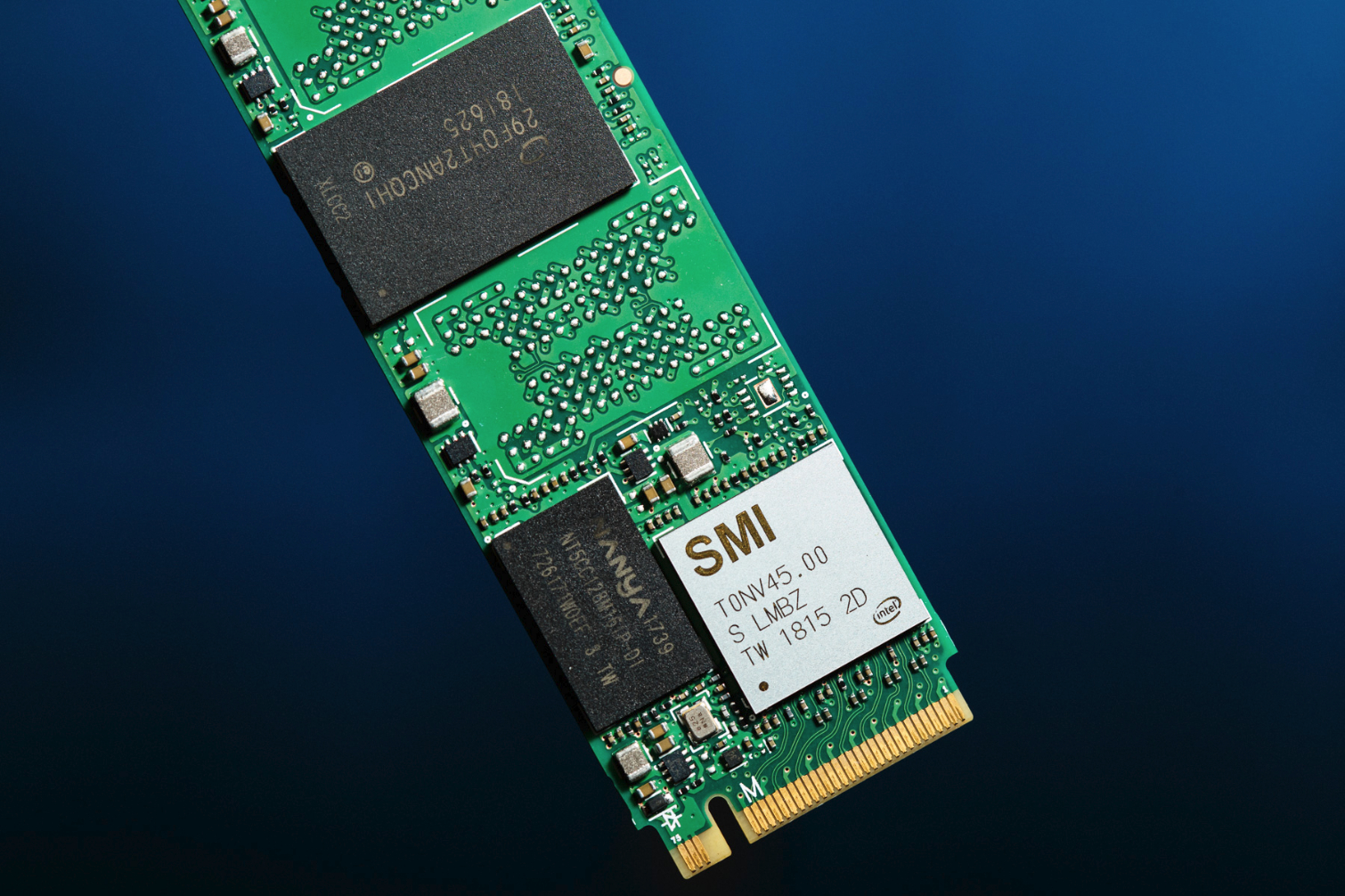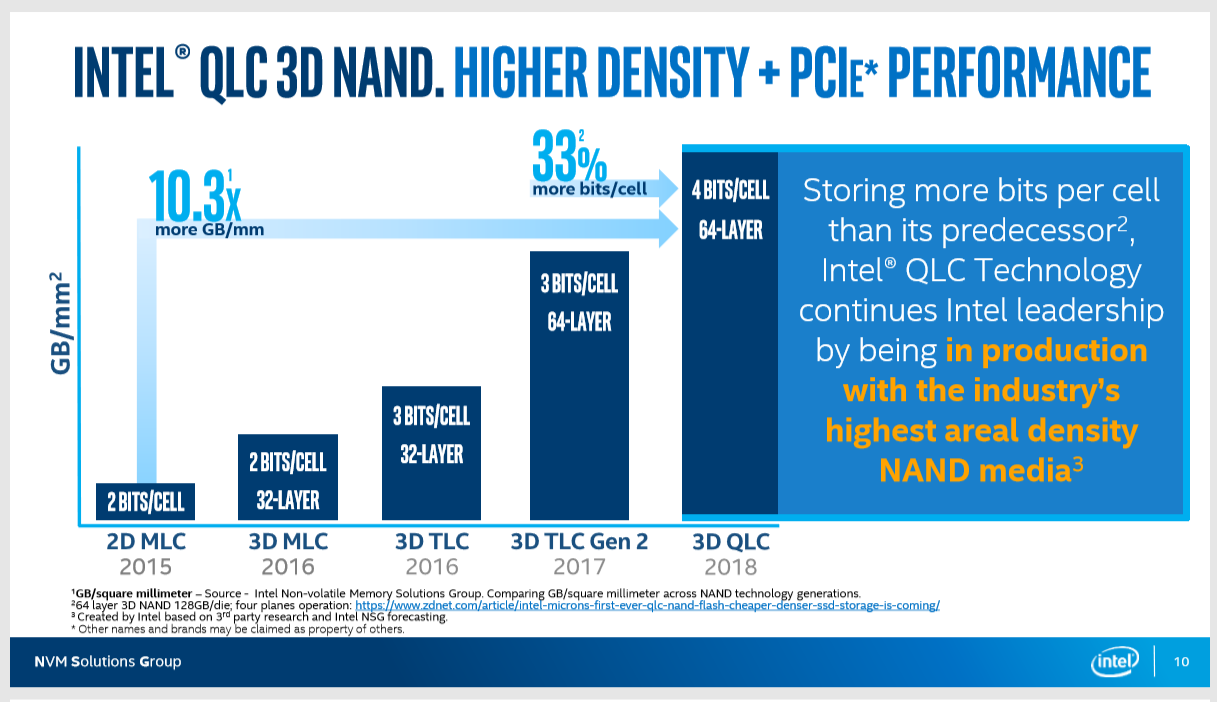Tom's Hardware Verdict
Like other capacities of the drive, the 2TB Intel SSD 660p lacks high endurance, and direct to QLC write speed is lackluster. But you get solid performance and efficiency under consumer-based workloads. Top things off, it’s significantly cheaper than the competition and often goes on sale, making it one of the best SSD values available.
Pros
- +
High-capacity M.2 2280 NVMe SSD
- +
High-capacity
- +
Competitive consumer performance
- +
Low price point
- +
Power-efficient
- +
Software package
Cons
- -
Slow native write performance
- -
Relatively low endurance
Why you can trust Tom's Hardware
12/6/2019 Update: We've updated this article with new testing for the 2TB 660p, as well as tweaked parts of the review to reflect current pricing.
When the Intel SSD 660p NVMe launched in summer 2018, it marked the arrival of the first consumer drive with QLC (quad-level cell) flash. Since then, the technology has appeared in a number of other SSDs as storage prices have dropped like a rock. At the same time, the Intel SSD 660p has become one of the best bargains in tech. With near-constant sales, you can often find the 660p selling for as little as $80 (£80) for a 1TB drive, though the 2TB models often go on sale for under $200 (£152).
One of the best SSDs you can get due to its mix of price and performance, the SSD 660p communicates over a fast PCIe 3.0 x4 and delivers up to 1.8 GB/s of throughput. It also offers surprisingly good performance in random workloads. If that wasn’t enough, the 660P comes with a five-year warranty.
We put the Intel SSD 660p 1TB capacity to the test and found that it offers a surprising amount of performance given its low price point. If your workload trends towards mundane daily tasks, like content consumption, office work, and web browsing, the 660p is a great solution with plenty of performance and endurance for most users. That said, if you like this SSD but wish it had more endurance, keep an eye out for the 660p's recently announced successor, the Intel SSD 665p, which promises slightly faster performance, and a 50% rated endurance bump.
While QLC sounds too good to be true, it’s not. Intel has a strong track record for developing new and innovative storage technology. The company was the first to bring NVMe SSDs to market four years ago with the Intel SSD 750 series, and it also developed the exotic 3D XPoint memory that it uses in the Optane products.
Intel’s 64-layer 3D QLC flash technology dramatically boosts flash storage capacity. MLC flash stores two bits per cell and TLC flash stores three, but QLC crams four bits into each cell. The 33% increase in density ultimately equates to more storage capacity for less money. Intel's QLC flash enables up to one 1-terabit (125GB) of storage capacity in a single die. SSD vendors can pack up to 16 die into a single package, which means QLC enables up to 2TB per package.
Just like Intel's other flash technology, QLC flash leverages the tried-and-true vertical floating gate flash cell design. Competing flash from other foundries use charge trap designs.
Get Tom's Hardware's best news and in-depth reviews, straight to your inbox.
High-capacity and inexpensive flash is music to everyone’s ears, but QLC has an Achilles heel. Well, two. QLC NAND has lower write performance and less endurance than MLC or TLC flash because it stores 16 different charge levels per cell to represent four bits of data. Due to the physical characteristics of flash, it's a challenge to store and modify 16 charge levels at the nanometer scale, especially as the flash ages. Cell-to-cell interference complicates the task. Intel claims the 3D floating gate design helps isolate the cells to reduce interference. In either case, sophisticated error correction algorithms, such as LDPC, are a key ingredient to boosting endurance.
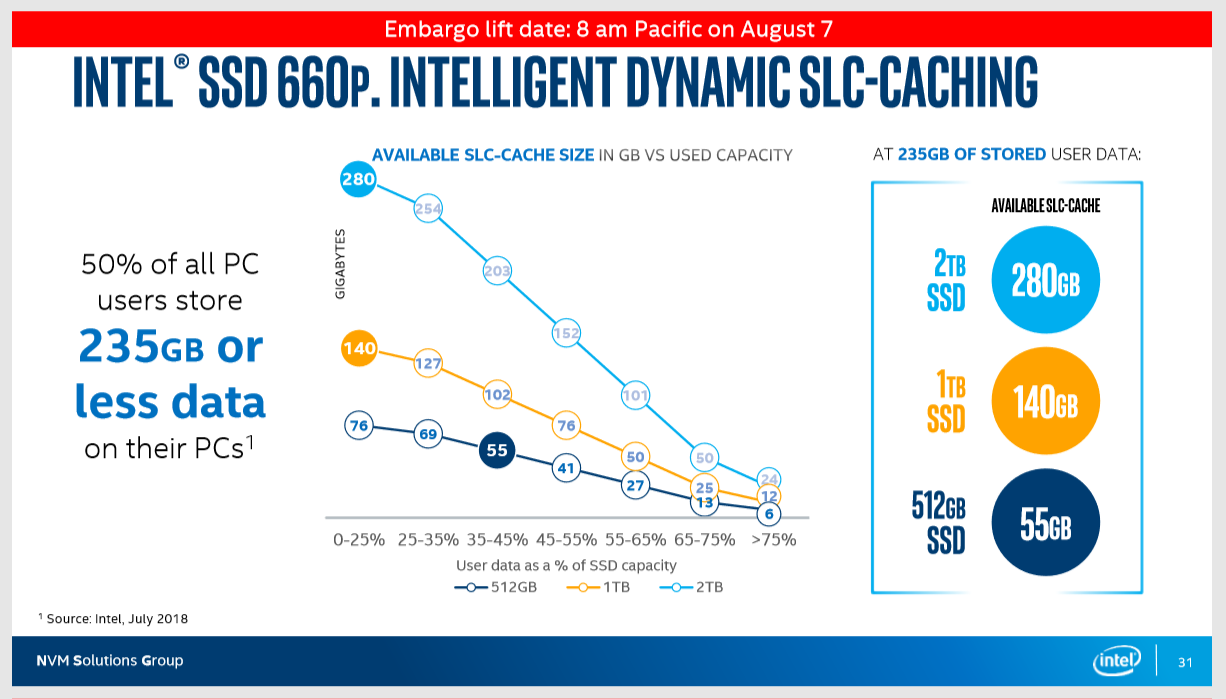

Intel sidesteps many of the performance challenges associated with QLC flash by tweaking the firmware and using intelligent idle time performance adjustments. Intel's Intelligent Dynamic SLC-Caching, which uses a pool of fast SLC flash to boost performance for incoming write data, takes a two-step approach.
First, the 660p has a static SLC cache that is 6GB, 12GB, or 24GB, depending upon SSD capacity. The static cache capacity never changes, but the SSD has a larger dynamic SLC cache pool that boosts performance further. The dynamic cache capacity adjusts bi-directionally based upon the amount of data stored on the SSD. In other words, the cache shrinks as you fill up the drive but expands as you delete items. Higher-capacity 660p's have larger dynamic SLC caches, as outlined in the chart above.
The SLC pool flushes to the QLC flash during idle periods, but Intel has a new on-demand performance boost option if you need your SLC performance back right away after bombarding the drive with writes. The feature allows you to flush the SLC cache to the QLC flash manually. Intel added this feature to its SSD optimizer in SSD Toolbox version 3.5.3.
Specifications
| Product | Intel SSD 660P 512GB | Intel SSD 660P 1TB | Intel SSD 660P 2TB |
|---|---|---|---|
| Pricing | $64 | $97 | $204 |
| Capacity (User / Raw) | 512GB / 512GB | 1024GB / 1024GB | 2048GB / 2048GB |
| Form Factor | M.2 2280 (single-sided) | M.2 2280 (single-sided) | M.2 2280 (single-sided) |
| Interface / Protocol | PCIe 3.0 x4 / NVMe 1.3 | PCIe 3.0 x4 / NVMe 1.3 | PCIe 3.0 x4 / NVMe 1.3 |
| Controller | SMI 2263 | SMI 2263 | SMI 2263 |
| DRAM | NANYA DDR3L | NANYA DDR3L | NANYA DDR3L |
| Memory | IMFT 64L 3D QLC | IMFT 64L 3D QLC | IMFT 64L 3D QLC |
| Sequential Read | 1,500 MB/s | 1,800 MB/s | 1,800 MB/s |
| Sequential Write | 1,000 MB/s | 1,800 MB/s | 1,800 MB/s |
| Random Read | 90,000 IOPS | 150,000 IOPS | 220,000 IOPS |
| Random Write | 220,000 IOPS | 220,000 IOPS | 220,000 IOPS |
| Encryption | AES-256 | AES-256 | AES-256 |
| Endurance | 100 TBW | 200 TBW | 400 TBW |
| Warranty | 5-Years | 5-Years | 5-Years |
| Part Number | SSDPEKNW512G8 | SSDPEKNW010T8 | SSDPEKNW020T8 |
Intel rates the 1TB and 2TB models for 1.8 GB/s of sequential read/write throughput, but the 512GB model steps back to 1.5/1 GB/s read/write. The write specification is based on the 660p’s dynamic SLC cache, however, so the drive could slow during extended write workloads when the workload spills over to the native QLC flash. We simulated the condition with a worst-case test, and the 1TB model fell to ~100 MB/s after writing 130GB of data from an empty state. Given the size of the 660p's SLC caches, you will likely never encounter this condition.
The 2TB Intel SSD 660p provides up to 220,000/200,000 random read/write IOPS, but the smaller models have slower random read performance. Our 1TB model provides up to 150,00 random read IOPS.
| Product | TBW | DWPD | Warranty |
|---|---|---|---|
| Intel SSD 660p 1TB | 200 | 0.11 | 5 |
| Intel SSD 600p/760p 1TB | 576 | 0.32 | 5 |
| Samsung 860/970 EVO 1TB | 600 | 0.33 | 5 |
| WD Black 1TB | 600 | 0.33 | 5 |
| WD Blue 3D 1TB | 400 | 0.2 | 3 |
| Crucial MX500 1TB | 360 | 0.2 | 5 |
Intel rates the 660p’s endurance as 100TBW per 512GB, or just over 0.1 drive write per day over the five-year warranty period. The 660p’s endurance is (on average) 33 percent lower than other PCIe based SSDs and roughly half that of budget SATA SSDs. Two hundred terabytes of write endurance might not seem like a lot, but Intel says it should be enough for most light, bursty workloads in desktop PCs. If your workloads are more intense, like frequent large file transfers, video processing, or workstation-class applications, other more endurant SSDs are a better choice.
The 660p features AES-256 encryption with Pyrite 1.0 and 2.0 support, which is a nice addition for the security conscious.
A Closer Look
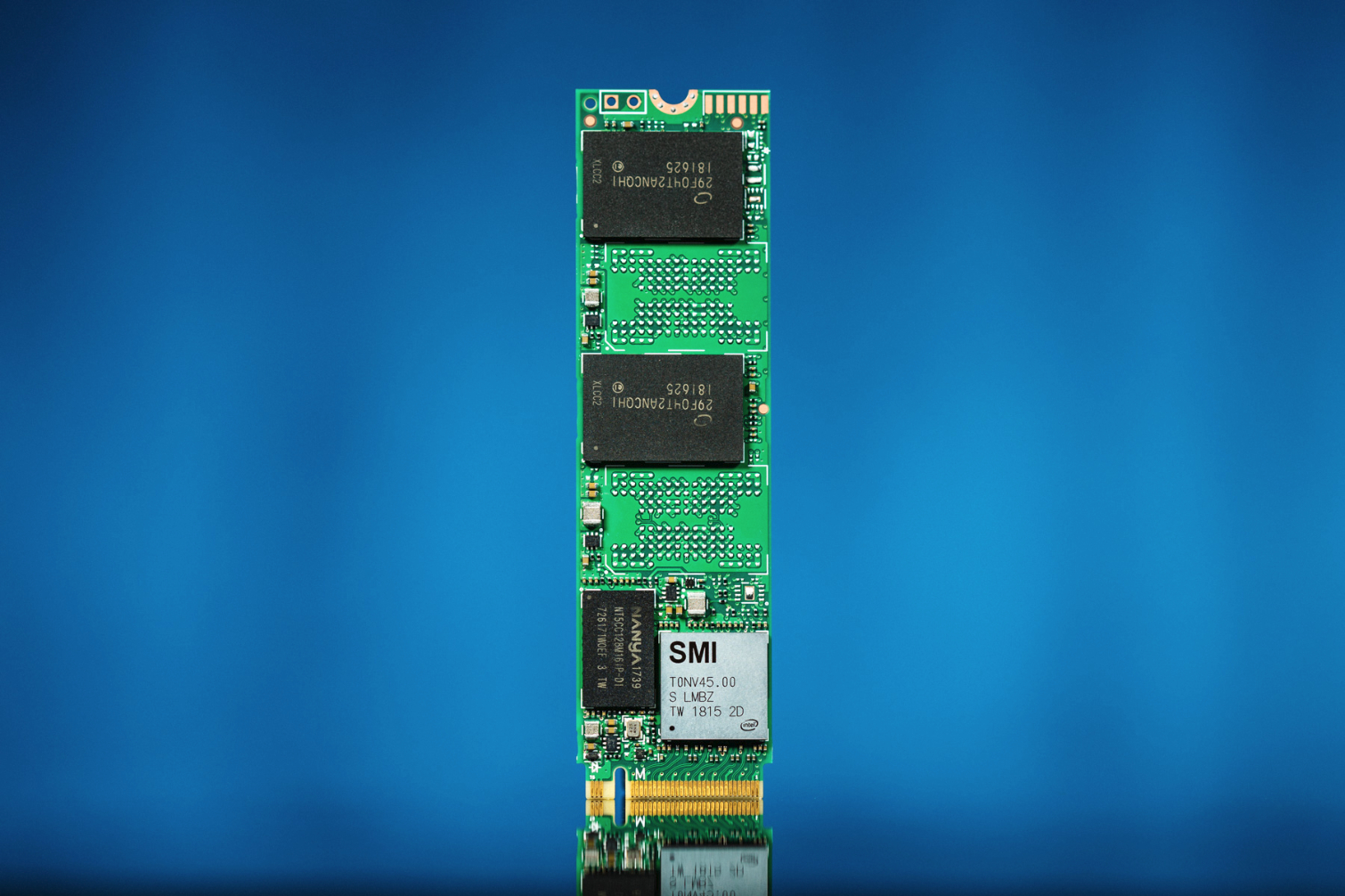

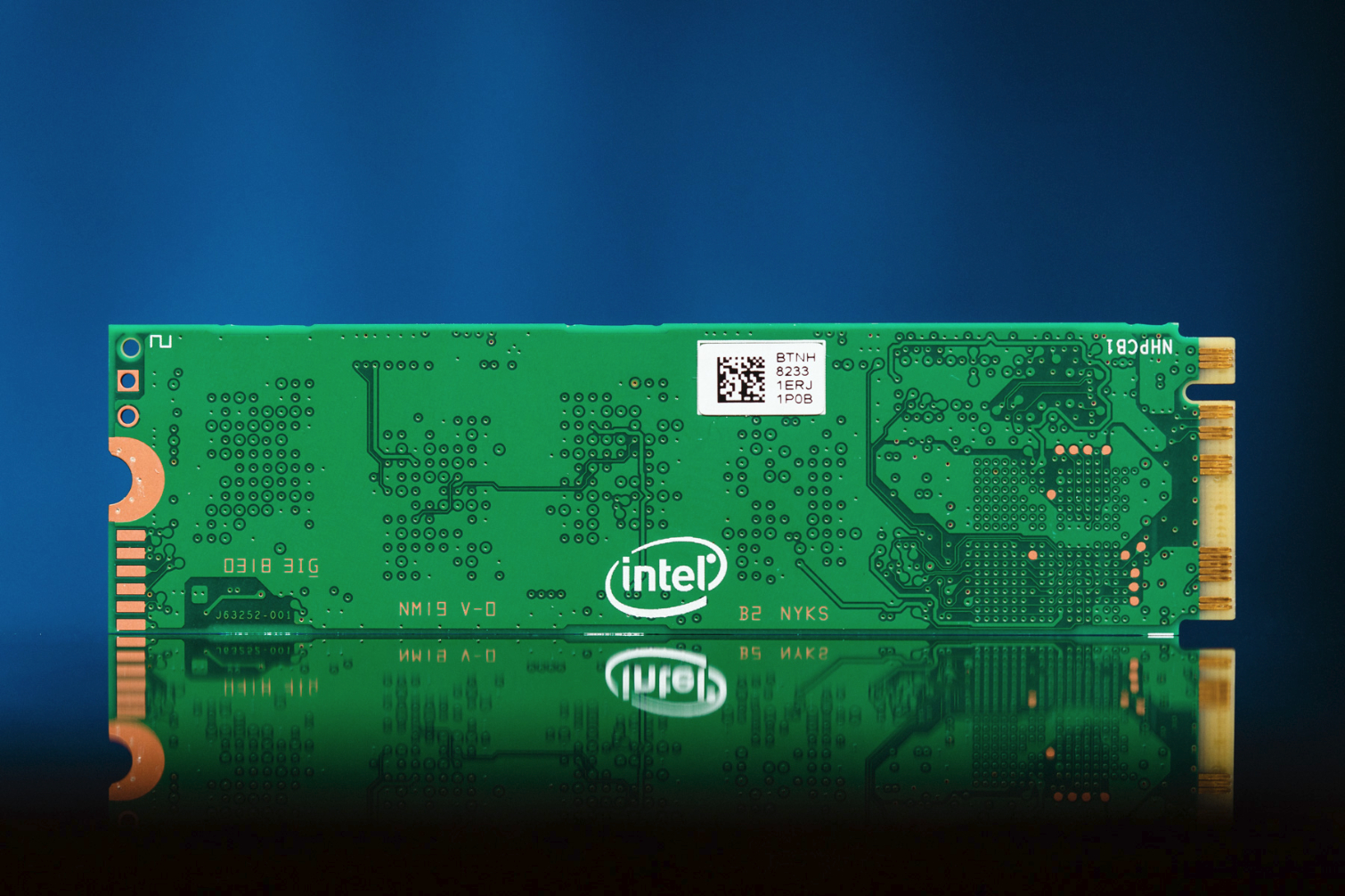
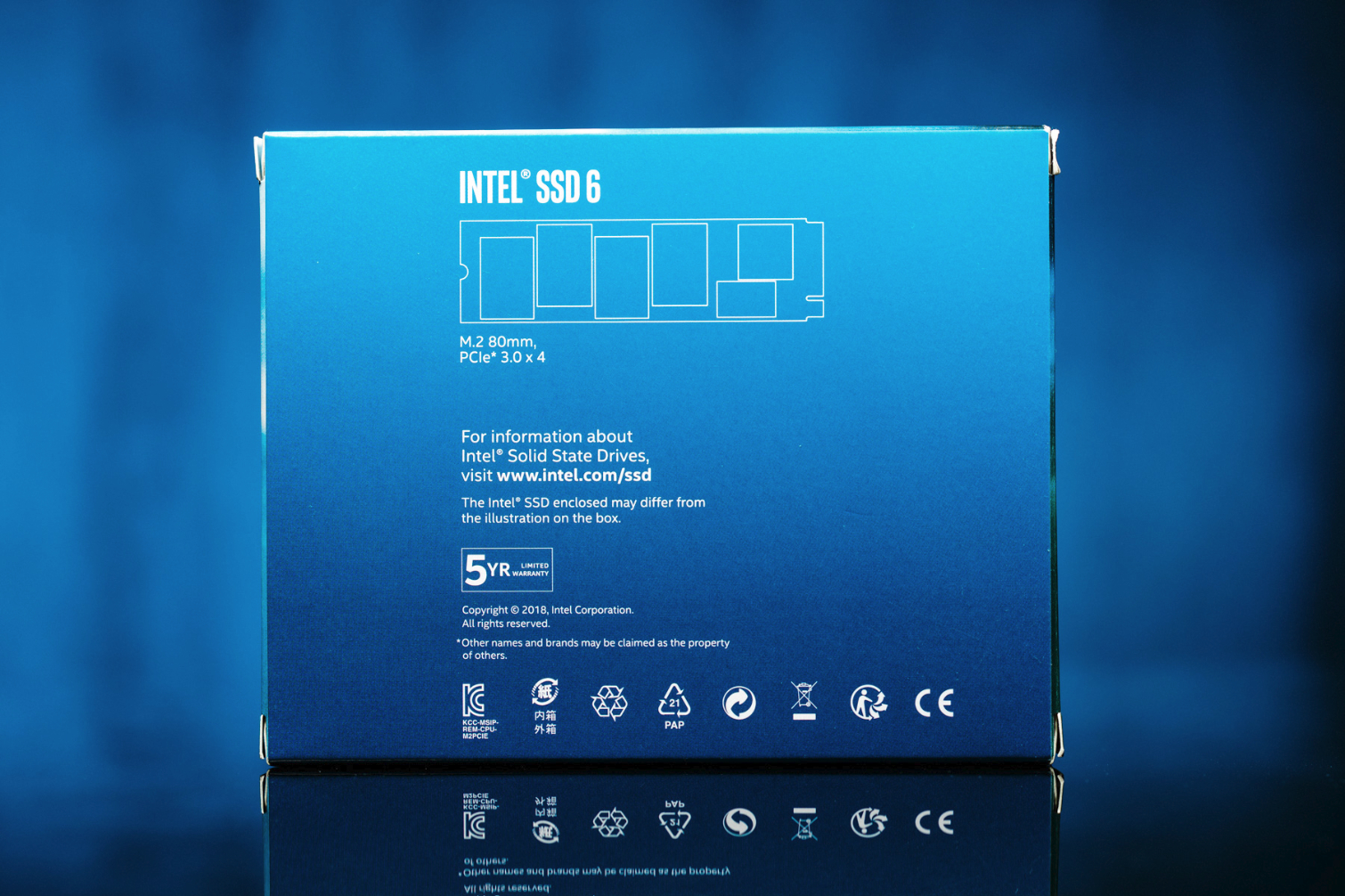
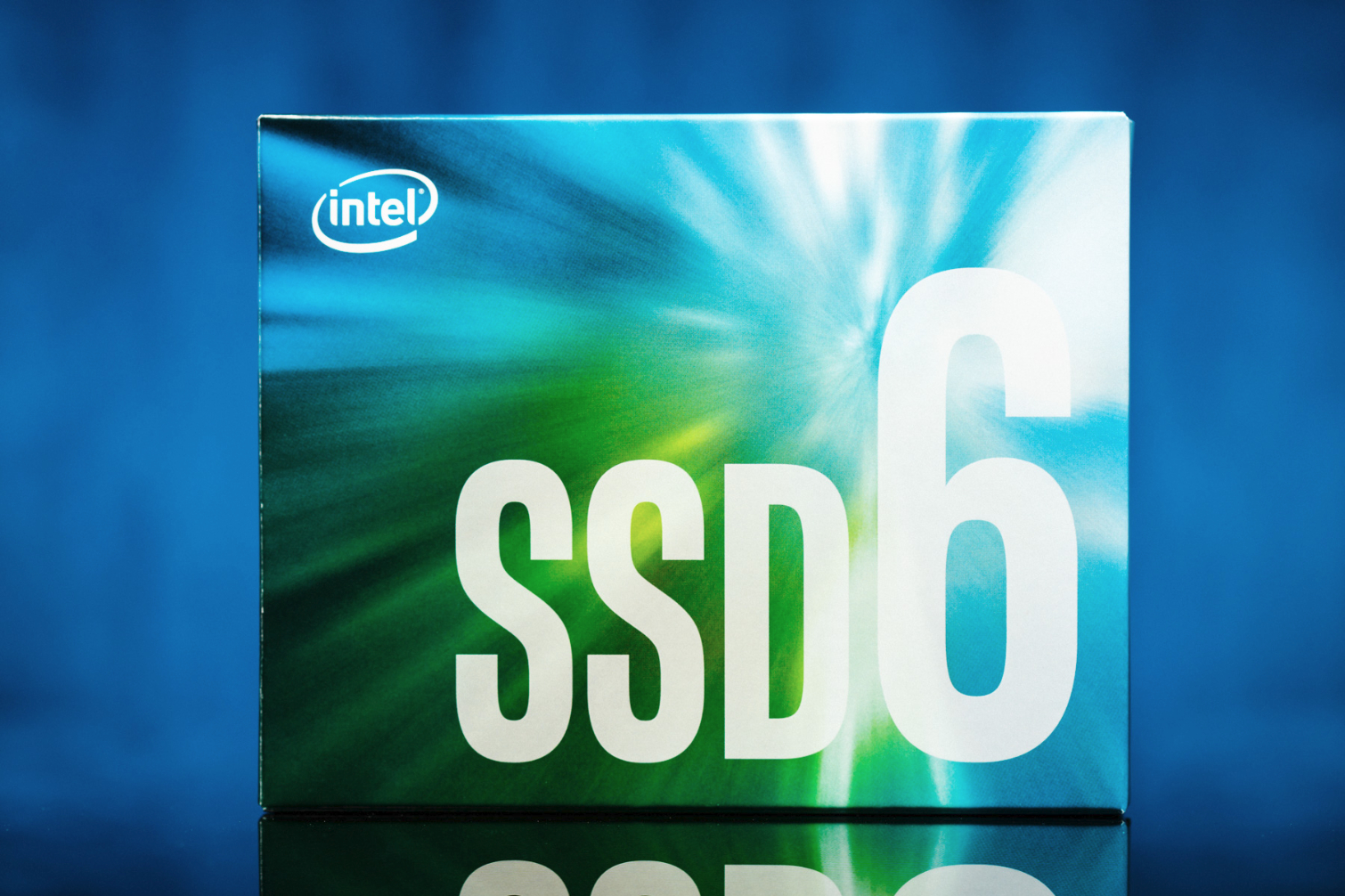
The Intel SSD 660p is a PCIe 3.0 x4 SSD that comes in an M.2 2280 single-sided form factor. It communicates with the host system via the NVMe 1.3 protocol and weighs in at just 5.5g. There are two 512GB 64-layer QLC flash emplacements on the PCB of the 1TB capacity.
The 660p comes with SMI's 2263 SSD controller and Intel's proprietary firmware. A single 256MB NANYA DDR3L DRAM chip flanks the controller. Most SSDs have a 1MB of DRAM to 1GB of flash ratio, but the Intel 660p has 1MB of DRAM per 4GB of flash. Intel could be compressing the LBA map or might have implemented the Host Memory Buffer (HMB) feature, which stores a portion of the LBA map in system memory.
MORE: Best SSDs
MORE: How We Test HDDs And SSDs
MORE: All SSD Content

Sean is a Contributing Editor at Tom’s Hardware US, covering storage hardware.
-
Giroro What is the real capacity of the 1TB drive?Reply
I really doubt the "raw" capacity really matches what the user sees, which is what the table says. So how much over-provisioning is Intel using with QLC compared to TLC?
Also, is hitting the endurance limits actually covered by the warranty? Or is Intel just planing on replacing a bunch of drives as they wear out in a year or two? Because, to me, calling 100 TBW endurance poor is an understatement. It's about one third of the TLC drives (which is not the same thing as "33% lower" by the way), and the TLC drives themselves have somewhat mediocre endurance.
Personally, I don't think a slightly lower price is worth the hassle and cost of replacing your SSD three times as often. I could buy 1 x 760p at $140 retail, or 3 x 660p for a total of $300 retail. That math doesn't work out for me. Plus, the 760p of the same capacity will have superior performance, which will be more clear when Toms reviews the 1TB 760p or the 512GB 660p, so there can be a direct comparison.
I think what is most annoying about QLC drives, is that cheap laptop OEMs are going to switch to them almost immediately, slap a 1 year warranty on the whole computer, then you are SOL when the drive wears out in 18 months. Intel will refuse to cover non-retail drives and just refer you back to the laptop OEM. Plus it's usually super annoying to repair/replace/upgrade the SSD in a laptop if you actually need to transfer any data. -
Paul Alcorn Reply21211903 said:What is the real capacity of the 1TB drive?
I really doubt the "raw" capacity really matches what the user sees, which is what the table says. So how much over-provisioning is Intel using with QLC compared to TLC?
Also, is hitting the endurance limits actually covered by the warranty? Or is Intel just planing on replacing a bunch of drives as they wear out in a year or two? Because, to me, calling 100 TBW endurance poor is an understatement. It's about one third of the TLC drives (which is not the same thing as "33% lower" by the way), and the TLC drives themselves have somewhat mediocre endurance.
Personally, I don't think a slightly lower price is worth the hassle and cost of replacing your SSD three times as often. I could buy 1 x 760p at $140 retail, or 3 x 660p for a total of $300 retail. That math doesn't work out for me. Plus, the 760p of the same capacity will have superior performance, which will be more clear when Toms reviews the 1TB 760p or the 512GB 660p, so there can be a direct comparison.
I think what is most annoying about QLC drives, is that cheap laptop OEMs are going to switch to them almost immediately, slap a 1 year warranty on the whole computer, then you are SOL when the drive wears out in 18 months. Intel will refuse to cover non-retail drives and just refer you back to the laptop OEM. Plus it's usually super annoying to repair/replace/upgrade the SSD in a laptop if you actually need to transfer any data.
It is important to remember how SSD endurance is measured.
The workload consists of a 4K random write to the full span of the drive while it is completely full of data. From an SSDs viewpoint, this is the absolute worst case scenario imaginable. The drive is full, which reduces its ability to boost endurance using common methods, like write combining or effective garbage collection, etc, so it forces the drive to not operate, or boost endurance, as it would normally.
The workload spans the entire space of the drive, which again just doesn't happen in normal application. SNIA guidelines for client SSD testing recommend a 16GB span, which changes the nature of the workload, and the impact to endurance. And a 16GB span is still far too large, imo.
These two factors magnify the impact to endurance to unrealistic levels, but the use of a 4K random write workload is even more brutal. Think of it as taking a shotgun to the flash. If you measure endurance with a sequential workload under the same sub-optimal and unrealistic conditions, the flash provides anywhere from 5x to 12x more endurance.
Also, endurance is rated by data retention, which is a function of time. The criteria for data retention is that after the endurance rating has been exhausted, you must be able to read back the data after the drive has set unpowered for a year.
So, during normal use the drive is not full to the extreme, which leads to increased endurance because the drive can operate correctly and mitigate the impact to endurance, and the workload does not span the full LBA range, which leads to increased endurance. Heavy pure 4K random write workloads are as rare as they come in a consumer desktop environment (even in the enterprise they are extremely rare), so the actual amount of data you can write during a typical mix of sequential and random workloads isn't even in the vicinity of the official endurance rating. Even after all that, if the endurance is exhausted and you keep the drive powered on a semi-regular basis (say, powering it up every six months), the amount of time before you would have an issue with data retention is lengthened.
In short, during real world use the SSD can handle far far beyond this rated endurance spec. -
DXRick PAULALCORN said "...you must be able to read back the data after the drive has set unpowered for a year."Reply
I built my current PC with a 1TB Black Edition WD around 7 years ago. So, that means there are files that have been sitting there for 7 years that have not degraded and are still 100% readable, or I would have serious problems. I would need an SSD to do the same in my next build. 1 year isn't a long enough retention period for, and given we aren't supposed to defrag SSDs I don't see what would cause some files to get re-written to another part of the drive.
Is there a weakness with SSDs for the lifetime of data that just sits there and is never updated?
Thanks! -
Paul Alcorn Reply21212567 said:PAULALCORN said "...you must be able to read back the data after the drive has set unpowered for a year."
I built my current PC with a 1TB Black Edition WD around 7 years ago. So, that means there are files that have been sitting there for 7 years that have not degraded and are still 100% readable, or I would have serious problems. I would need an SSD to do the same in my next build. 1 year isn't a long enough retention period for, and given we aren't supposed to defrag SSDs I don't see what would cause some files to get re-written to another part of the drive.
Is there a weakness with SSDs for the lifetime of data that just sits there and is never updated?
Thanks!
You haven't powered the computer up for a year? As in, turned it on?
The statement is about the SSD not being powered for a year. Turned off.
-
richardvday Yes I think your missing the part about NO POWER to the drive for a year.Reply
If you power your system up every 11 months( if you leave it off that long cant be important can it ?) it should still work is what he is saying.
A HDD on the other hand can sit off for much longer and still retain your data.
Just power it up everytime DST kicks in every 6 months :) -
unityole though I do like added power test during use not just idle, whats with the review tests seems all changed. we longer see seq read/write nor random read/write performance at QD1-4.Reply
further more with TLC especially more so on QLC, I want to see the speed while saturated by write to see the real write performance of QLC flash. please include a HD tune test write test entire drive so we can see the dip in performance going from SLC caching being filled to real QLC performance. -
cryoburner Reply
How many people are actually going to write 100,000GB of data to any drive? Under most typical usage scenarios, the vast majority of people won't be writing more than 20GB of data to their system drive each day, and most common users will write far less than that, maybe averaging a few GB or so. Even at 20GB per day, which would actually be rather high, it would take more than 13 years to hit that amount of writes, so the suggestion of having to replace the drive more often is nonsensical. By that point, the drive should be long obsolete, and you'll likely be able to get much faster, higher capacity drives at a fraction of the cost. So, no, I don't see 100TBW endurance being a problem. To hit that amount of usage within the drive's 5 year warranty, you would need to write around 55GB of data to the drive each day, and that's not going to be something likely to happen outside of certain specialized professional tasks. Obviously, hitting the write endurance limit won't be covered by warranty, but it's not something likely to happen within the drive's warranty period either. And 100TBW is for the 512GB drive, not the 1TB drive reviewed here, which has double the endurance.21211903 said:Also, is hitting the endurance limits actually covered by the warranty? Or is Intel just planing on replacing a bunch of drives as they wear out in a year or two? Because, to me, calling 100 TBW endurance poor is an understatement. It's about one third of the TLC drives (which is not the same thing as "33% lower" by the way), and the TLC drives themselves have somewhat mediocre endurance.
Personally, I don't think a slightly lower price is worth the hassle and cost of replacing your SSD three times as often. I could buy 1 x 760p at $140 retail, or 3 x 660p for a total of $300 retail. That math doesn't work out for me. Plus, the 760p of the same capacity will have superior performance, which will be more clear when Toms reviews the 1TB 760p or the 512GB 660p, so there can be a direct comparison.
I think what is most annoying about QLC drives, is that cheap laptop OEMs are going to switch to them almost immediately, slap a 1 year warranty on the whole computer, then you are SOL when the drive wears out in 18 months. Intel will refuse to cover non-retail drives and just refer you back to the laptop OEM. Plus it's usually super annoying to repair/replace/upgrade the SSD in a laptop if you actually need to transfer any data.
I think this drive looks great, offering much higher performance at SATA SSD prices. It's hard to justify the premium pricing for most NVME drives when they only perform marginally better than a SATA drive in most real-world tasks. Of course, I suspect this may cause other drives to drop in price to compensate. I would like to see the 512GB drive reviewed though, since that is still a much more popular capacity for SSDs. Judging by the official specs, it looks like performance may take a significant hit, but it will be interesting to see just how that plays out compared to the 1TB model and SATA SSDs in that price range. -
timothy.atwood This is way slower than my current 3x4 PCIe NVME SSD drive. Do not see the benefits when I paid 129 for this 500GB drive that matches the Samsung 970 in speed.Reply -
kultraleader Samsung 960 EVO 1TB is $300 that has two times faster read and write speed. and three times 300%+ more endurant. Price $199 VS $300. not much price difference but we lose 300%+ endurant !!! so Intel SSD 660p 1TB should be only worth $149, not $199. $199 is overpriced.Reply
